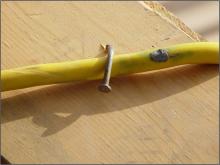Electrical Safety: May is National Electricity Safety month

Did you know that 126 workers died from exposure to electricity in 2020?
Electricity and electrical products play fundamental roles in our lives each and every day. However, if not used or maintained appropriately, electricity can pose serious risks. Over the last ten years, more than 20,000 workers have been injured in workplace electrical accidents in the United States.
We take electricity for granted in our work and home lives, and, there’s pretty much zero occupations in the world that don’t expose people or have them use electricity.
Working with electricity can be dangerous. Engineers, electricians, and other professionals work with electricity directly, including working on overhead lines, cable harnesses, and circuit assemblies. Others, such as office workers and laboratory personnel, may work with electricity indirectly and may also be exposed to electrical hazards. Electricity has long been recognized as a serious workplace hazard. OSHA's electrical standards are designed to protect employees exposed to dangers such as electric shock, electrocution, fires, and explosions.
These are some basic issues when it comes to safety in the workplace, and there are easy ways to protect yourself.
This article details basic electrical hazards, circuit breakers and fuses, ground fault circuit interrupters, and other issues with electricity.
What are some basic Electrical Safety Issues?
- Extension Cords/Power Strips overloaded.
- Extension cords should not be used in place of permanent wiring.
- Ensure that cords are in proper working condition (the outer insulation should not be cracked/broken; the ground pin needs to be intact). Discard unsafe extension cords.
- Only licensed electricians are authorized to replace plugs or splice cords.
- Extension cords need to be protected from motor vehicles, forklifts, pallet jacks,heavy pedestrian traffic, etc.
- Power strips should not be permanently mounted to a wall or any other structure,even if the power strip has specific mounting fittings.
- Power strips or extension cords should not be connected to each other. Doing this can overload the circuit creating a potential fire hazard.
What are circuit breakers and fuses?
Circuit breakers and fuses are found in electrical boxes.
- These devices are designed to protect the wiring in a house/building and to prevent a potential fire.
- Fuses: Open the circuit when too much current is flowing through the circuit. A small conductor inside the fuse heats up and melts when it reaches a specific temperature.
- Circuit Breakers: As current increases in the circuit, an electromagnet inside the breaker generates increased magnetic force, eventually being great enough to pull the switch on the breaker from the “on” to the “off” position.
What is a ground fault circuit interrupter (GFCI) and how do they protect us?
GFCI’s are found in bathrooms and kitchens. They are installed to protect individuals from electrocution.
- GFCIs are designed to protect people from electric shock.
- A GFCI works by detecting a current drop from the hot to the neutral wiring in a Circuit (Detects the energy escaping from the circuit).
- GFCIs should be installed wherever a water source is present.
- You will commonly find GFCI plugs on hairdryers, wet vacs, etc.
- GFCIs can be at the breaker, the outlet, incorporated with the plug of the appliance/piece of equipment, or part of a short extension cord.
What are some other electrical safety issues in the workplace and home.
- Discard any piece of equipment that gives you even the slightest shock. If the resistance through your body is lowered, i.e. standing in water or touching metal,even the slightest shock can be deadly.
- Never use electrical equipment in or around water.
- Junction boxes and electrical panels within 8’ of the floor need to have proper covers in place to conceal all wiring.
- Hard wiring should not be exposed/accessible to non-electrical employees.
- Keep areas around electrical panel clear three feet in the of the panel
Summary
Take a look at the images below. What are your thoughts about these situations? Hopefully, you realize that these situations are dangerous and should be corrected.
Keep in mind that electricity, when used correctly is safe, but remember the information from above. Please check EHS’s Electrical safety program and contact EHS for any questions or interest in training.



Sources
1. basic_electrical_safety_fact_sheet.pdf (harvard.edu)
2. NFPA - Fatal electrical injuries at work
3. Electrical Safety | EH&S (harvard.edu)
4. Basics of Electrical Safety
This article is presented by Kent State EHS. Please check out our website for more information.
